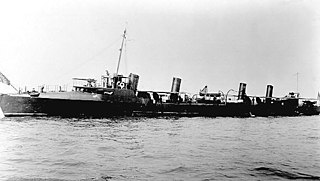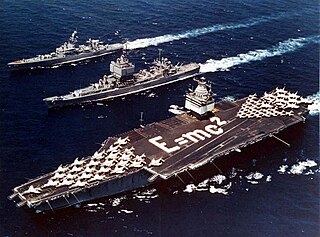
The fifth USS Truxtun (DLGN-35/CGN-35) was a nuclear powered cruiser in the U.S. Navy. She was launched as a destroyer leader and later reclassified as a cruiser. She was named after Commodore Thomas Truxtun (1755–1822). She was in service from May 1967 to September 1995.

Destroyer escort (DE) was the United States Navy mid-20th-century classification for a 20-knot warship designed with the endurance necessary to escort mid-ocean convoys of merchant marine ships.

The Clemson class was a series of 156 destroyers which served with the United States Navy from after World War I through World War II.

USS Truxtun (DDG-103) is an Arleigh Burke-class destroyer currently in service with the United States Navy. She is named for American Naval hero, Commodore Thomas Truxtun (1755–1822), one of the first six commanders appointed by George Washington, to the newly formed U.S. Navy. She is the sixth U.S. naval warship to bear his name.

The destroyers-for-bases deal was an agreement between the United States and the United Kingdom on September 2, 1940, according to which 50 Caldwell, Wickes, and Clemson-class US Navy destroyers were transferred to the Royal Navy from the US Navy in exchange for land rights on British possessions.

The Town-class destroyers were a group of 50 destroyers of the Royal Navy and the Royal Canadian Navy that were in service during the Second World War. They were transferred from the United States Navy in exchange for military bases in the British West Indies and Newfoundland, as outlined in the Destroyers for Bases Agreement between Britain and United States, signed on 2 September 1940. They were known as "four-pipers" or "four-stackers" because they had four smokestacks (funnels). Later classes of destroyers typically had one or two.
A destroyer squadron is a naval squadron or flotilla usually consisting of destroyers rather than other types of vessel. In some navies other vessels, such as frigates, may be included. In English the word "squadron" tends to be used for larger and "flotilla" for smaller vessels; both may be used for destroyer units. Similar formations are used in non-English-speaking countries, e.g., the "escadrille"—which would translate directly as "squadron"—in France.

The second USS Truxtun (DD-14) was the lead ship of Truxtun-class destroyers in the United States Navy. She was named for Commodore Thomas Truxtun.

Three Truxtun-class destroyers were built for the United States Navy. Part of the original 16 destroyers authorized by Congress on 4 May 1898 for the fiscal year 1899 program, they were commissioned in 1902. They were very similar to their Bainbridge-class contemporaries, except for mounting six 6-pounder (57 mm) guns instead of five. They were considered the most successful of the first 16 US Navy destroyers, and were succeeded by the larger Smith class.

The Bainbridge-class destroyers were a class of United States Navy Torpedo Boat Destroyers (TBDs) built between 1899 and 1903. The first class so designated, they comprised the first 13 of 16 TBDs authorized by Congress in 1898 following the Spanish–American War. One ship of the class was lost at sea during service in World War I: Chauncey, which collided with the British merchant ship SS Rose in 1917. The balance were decommissioned in 1919 and sold postwar in 1920, eleven to Joseph G. Hitner of Philadelphia, and the Hopkins to the Denton Shore Lumber Company in Tampa, Florida.

The Smith-class destroyers were the first ocean-going torpedo-boat destroyers in the United States Navy, and the first to be driven by steam turbines instead of the reciprocating engines fitted in the sixteen earlier and much smaller torpedo-boat destroyers ordered under the Act of 4 May 1898. Flusser and Reid are sometimes considered to be Flusser-class ships. Also, since Flusser was completed first, some period documentation refers to the entire class as Flussers.

USS Truxtun (DD-229) was a Clemson-class destroyer in the United States Navy during World War II. She was the third ship named for Thomas Truxtun.

Mark 32 Surface Vessel Torpedo Tubes is a torpedo launching system designed for the United States Navy.

The Belknap-class cruiser was a class of single-ended guided-missile cruisers built for the United States Navy during the 1960s. They were originally designated as DLG frigates, but in the 1975 fleet realignment, they were reclassified as guided missile cruisers (CG).
United States ship naming conventions for the U.S. Navy were established by congressional action at least as early as 1862. Title 13, section 1531, of the U.S. Code, enacted in that year, reads, in part,
The vessels of the Navy shall be named by the Secretary of the Navy under direction of the President according to the following rule: Sailing-vessels of the first class shall be named after the States of the Union, those of the second class after the rivers, those of the third class after the principal cities and towns and those of the fourth class as the President may direct.

The Mark 42 5"/54 caliber gun (127mm) is a naval gun mount used by the United States Navy and other countries. It consisted of the Mark 18 gun and Mark 42 gun mount. United States naval gun terminology indicates the gun fires a projectile 5 inches (127.0 mm) in diameter, and the barrel is 54 calibers long In the 1950s a gun with more range and a faster rate of fire than the 5"/38 caliber gun used in World War II was needed, therefore, the gun was created concurrently with the 3"/70 Mark 26 gun for different usages. The 5"/54 Mk 42 is an automatic, dual-purpose gun mount. It is usually controlled remotely from the Mk 68 Gun Fire Control System, or locally from the mount at the One Man Control (OMC) station.

USS Truxtun (APD-98) was a Crosley-class high-speed transport commissioned in the United States Navy from 1945 to 1946. In 1965, she was transferred to the Republic of China Navy and served as ROCS Fu Shan (PF-35) until 1996. Afterwards, she was scrapped.

In the early 1960s, the United States Navy was the world's first to have nuclear-powered cruisers as part of its fleet. The first such ship was USS Long Beach (CGN-9). Commissioned in late summer 1961, she was the world's first nuclear-powered surface combatant. She was followed a year later by USS Bainbridge (DLGN-25). While Long Beach was a 'true cruiser', meaning she was designed and built as a cruiser, Bainbridge began life as a frigate, though at that time the Navy was using the hull code "DLGN" for "destroyer leader, guided missile, nuclear". This was prior to the enactment of the 1975 ship reclassification plan, in which frigates (DLG/DLGN), which were essentially large destroyers, were reclassified as cruisers, so that the US Navy's numbers would compete with those of the Soviet Navy. Long Beach, the largest of all the nuclear cruisers, was equipped with a C1W cruiser reactor, while all the others were equipped with D2G destroyer reactors.
There have been a number of 18-inch torpedoes in service with the United States. These have been used on ships and submarines of the US Navy. American "18-inch" torpedoes were actually 17.7 inches (45 cm) in diameter, beginning with the "Fiume" Whitehead torpedo of 1890.















